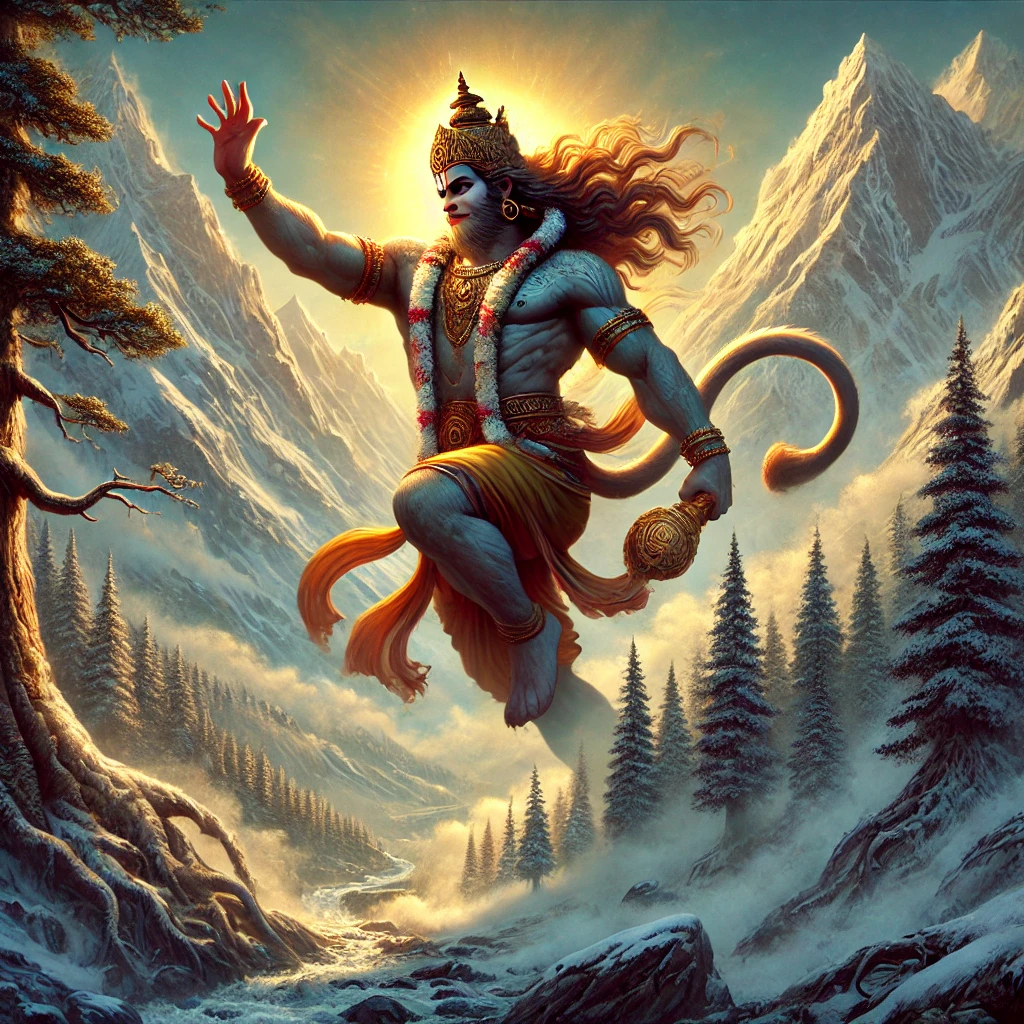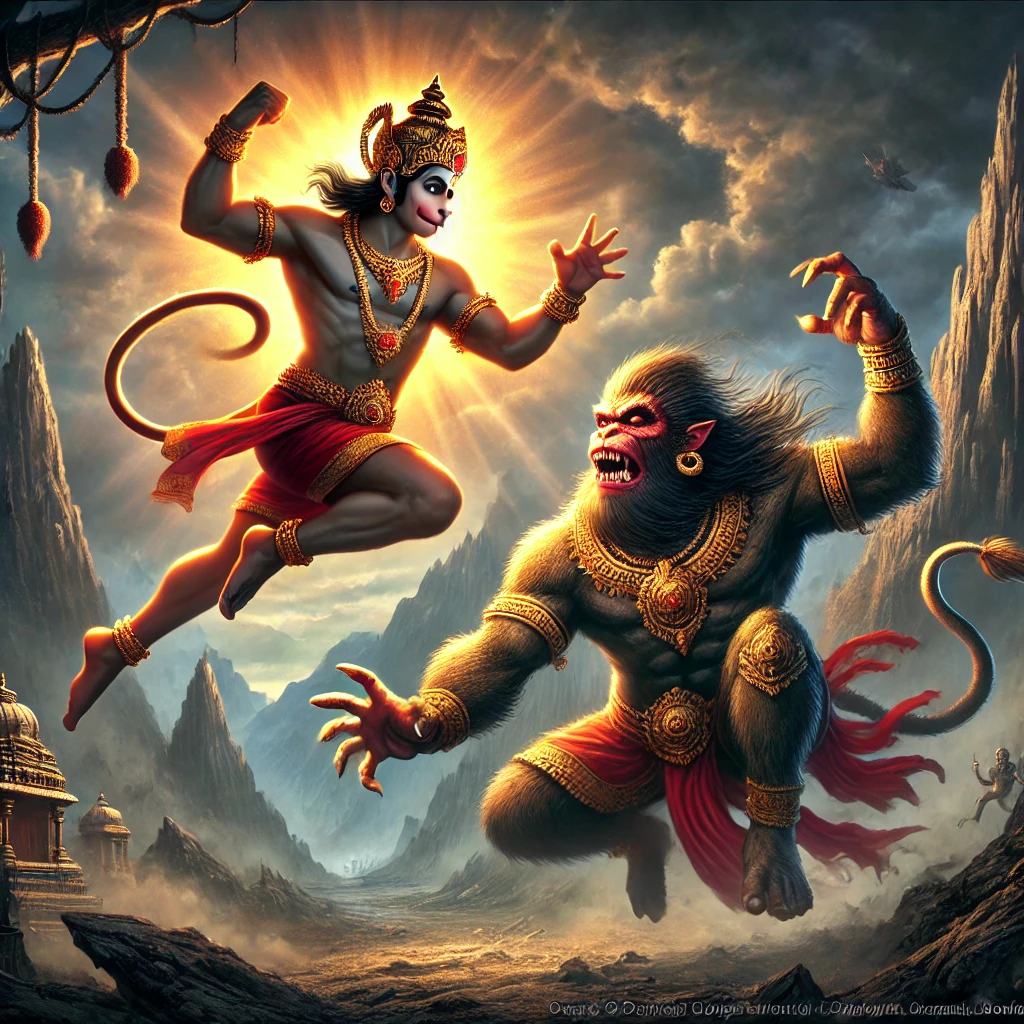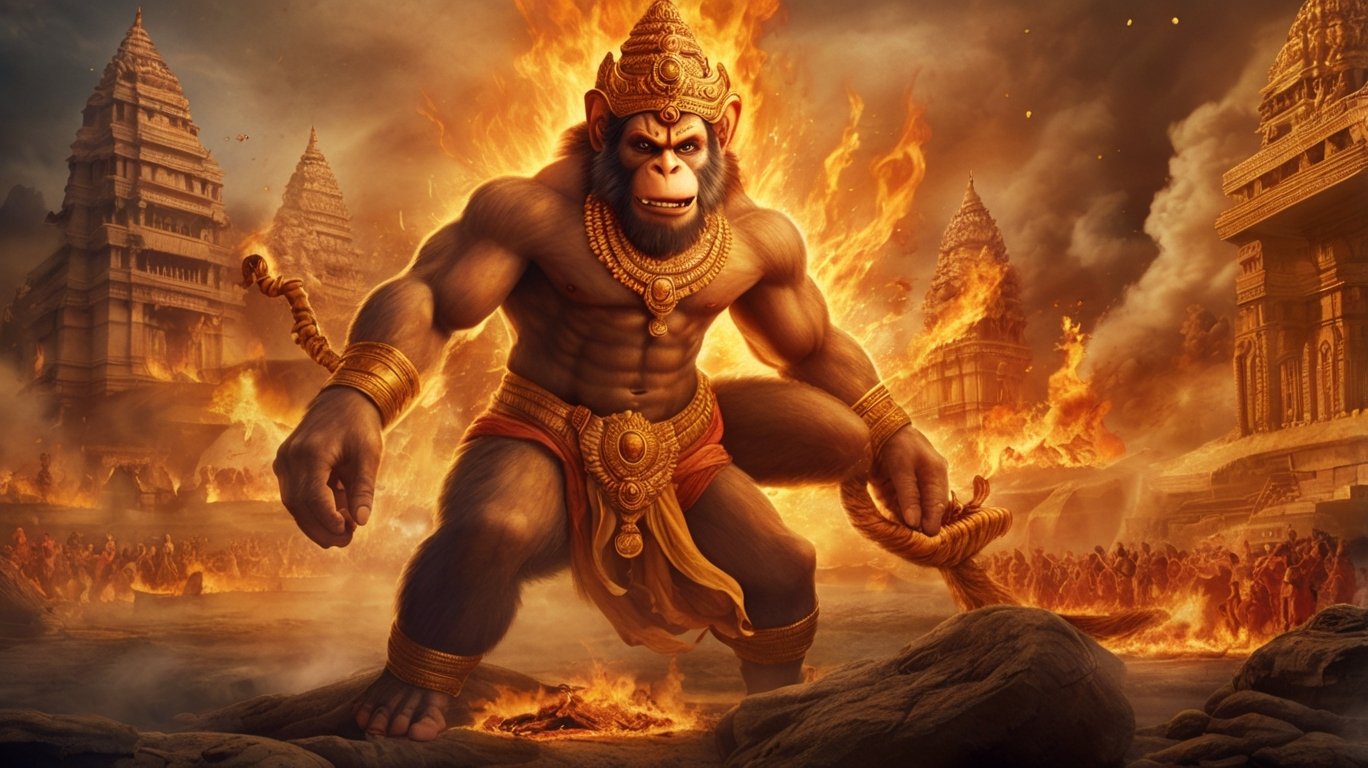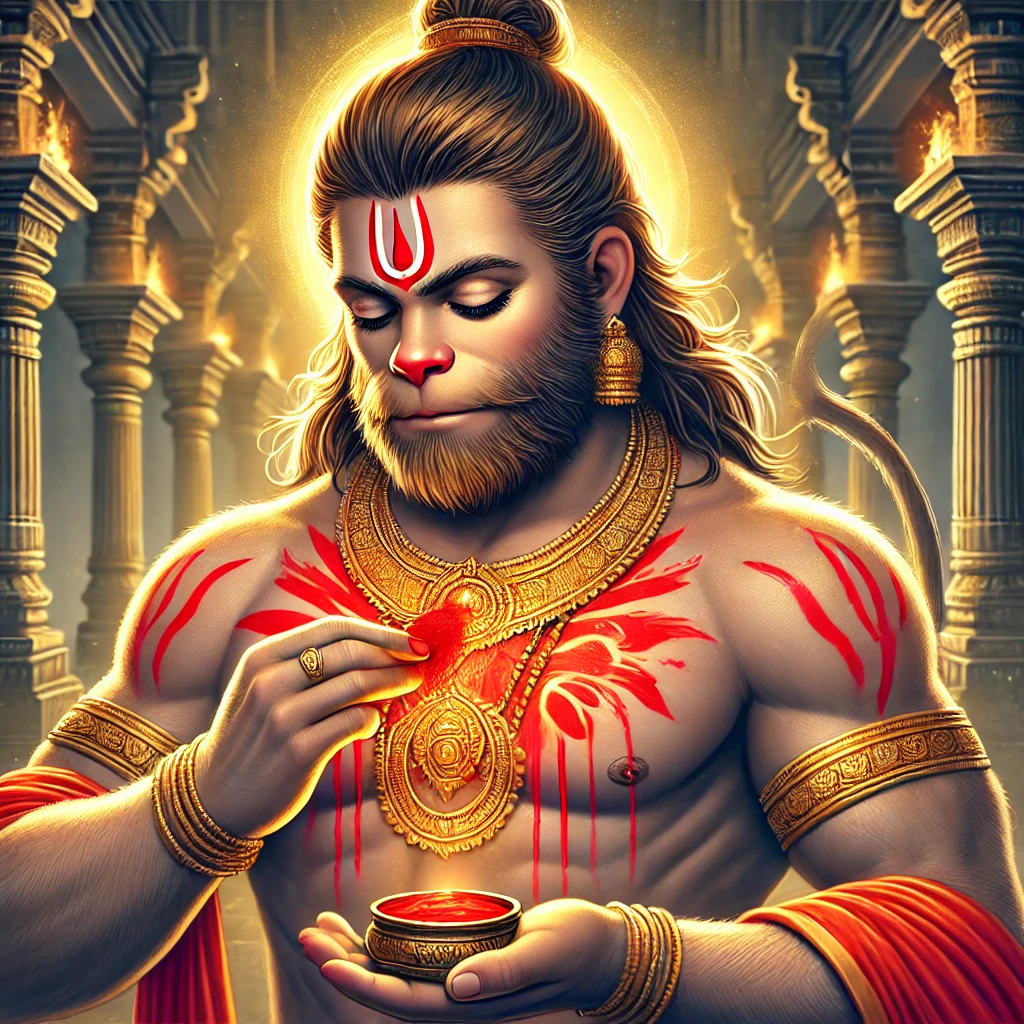Table of Contents
Introduction
Welcome to Bedesii.com, where we embark on a journey through India’s timeless spiritual heritage and sacred tales. At Bedesii, our mission is to illuminate the wisdom, devotion, and practices enshrined in Hindu mythology and spiritual traditions, aiming to foster inner peace, mindfulness, and positivity in daily life. We believe that these ancient stories are more than mere tales; they are rich tapestries woven with life lessons, moral insights, and pathways to emotional healing that hold relevance for every era.
Today, as we dive into the story of Hanuman and Kalanemi, we invite you to explore a narrative that transcends heroism and delves deep into devotion, loyalty, and the triumph of good over deception. Hanuman’s journey to obtain the Sanjeevani herb and his encounter with the demon Kalanemi is one of courage, resilience, and unwavering faith. At Bedesii.com, we are passionate about bringing such stories to life—not just through recounting events but by exploring the deeper insights that lie within them. Through understanding these ancient tales, we can draw parallels to the challenges we face in modern life and find inspiration in the divine qualities that our deities and spiritual figures embody.
The Bedesii team is dedicated to presenting these stories with accuracy, depth, and reverence, ensuring that readers of all ages and backgrounds can connect with and find meaning in them. Our platform goes beyond storytelling; it offers resources, discussions, and practices that encourage spiritual growth and holistic well-being. Each story, like that of Hanuman and Kalanemi, is a reminder of the enduring power of faith and the strength found within when one walks the path of righteousness.
We warmly welcome you to this narrative, hoping it brings not only insight into Hanuman’s unparalleled devotion but also inspiration for your own spiritual journey. Let us dive together into this tale of valor, wisdom, and divine purpose, as we explore the eternal values that have shaped the lives of millions over centuries.

Setting the Stage: The War in Lanka
The war between Lord Rama and Ravana had reached a critical phase. Ravana, the demon king of Lanka, was desperate to protect his kingdom and family from Rama’s relentless siege. Ravana’s forces were gradually being overpowered, despite his powerful army of demons. Lakshmana, Lord Rama’s brother, was the chief warrior in Rama’s army, and his valiance was instrumental in advancing the battle.
However, Indrajit, Ravana’s son, was a formidable adversary. Known for his mastery over magical weapons and strategies, Indrajit wielded the Nagapasha, a celestial weapon made of serpents, and bound Lakshmana with it during one of the battles. Despite efforts to protect him, Lakshmana was severely injured and lay on the brink of death.
The Call for Sanjeevani: A Matter of Life and Death
The only cure for Lakshmana’s critical condition was the Sanjeevani herb, a divine plant known for its life-restoring powers. According to Ayurveda and ancient Hindu lore, the Sanjeevani has properties that can heal the gravest of injuries and even restore life. This herb was rare and found only on Mount Dronagiri in the Himalayan range, located thousands of miles from Lanka.
Lord Rama, deeply distressed by his brother’s injury, turned to his most trusted devotee, Hanuman, and requested him to bring the Sanjeevani. Hanuman’s devotion to Rama was boundless. Without a moment’s hesitation, he pledged to accomplish this mission, regardless of the obstacles that lay in his path.
Hanuman’s Determination and the Journey Begins
Hanuman’s journey to the Himalayas was no ordinary feat. As the son of the wind god Vayu and known for his astounding speed, he possessed the ability to soar through the skies. When Hanuman set out, the distance from Lanka to the Himalayas was daunting, covering a journey of nearly 1,700 miles. Yet, he took it upon himself as an act of service, motivated by his unwavering devotion and loyalty.
To reach Dronagiri swiftly, Hanuman invoked his Ashta Siddhis and Nava Nidhis, divine powers and blessings granted to him. These included the power to expand and contract his body at will, become invisible, and transcend the constraints of time and space. Despite knowing that he would face unknown dangers, Hanuman was determined to fulfill Lord Rama’s command.
Ravana’s Plot to Stop Hanuman: Enlisting Kalanemi
Meanwhile, Ravana was becoming increasingly aware of Hanuman’s capabilities. He knew that if Hanuman succeeded in bringing back the Sanjeevani, Lakshmana would be revived, and the battle would turn in Rama’s favor. Desperate to prevent this, Ravana summoned Kalanemi, a powerful demon and a sorcerer in Ravana’s service.
Kalanemi was no ordinary demon; he was known for his magical abilities and his mastery over illusion and deception. Although Kalanemi was initially reluctant to oppose a being as powerful as Hanuman, Ravana convinced him by promising him wealth and power beyond imagination. Kalanemi, despite his reluctance, finally accepted Ravana’s orders and devised a sinister plan.
Kalanemi’s Illusionary Hermitage
Kalanemi’s plan to deceive Hanuman was intricate and well-thought-out. He knew that a direct confrontation with Hanuman would be futile, so he resorted to trickery. Kalanemi created an illusionary hermitage that radiated an aura of peace and divinity, hoping to lure Hanuman into a trap. The hermitage was crafted to look like a serene ashram, with an aura of calm and spirituality.
In the middle of the hermitage, Kalanemi created a tranquil lake surrounded by blooming lotuses, lush trees, and an atmosphere of divine silence, perfect for tempting any weary traveler. Kalanemi himself disguised as an aged sage, dressed in ascetic robes and wielding a staff. He was confident that his trickery would be enough to delay Hanuman or, if luck was on his side, defeat him.
The Arrival of Hanuman at Kalanemi’s Lake
As Hanuman soared across the lands, he saw the beautiful hermitage and the inviting lake below. Although he was on an urgent mission, he decided to stop for a brief moment to quench his thirst. When Hanuman landed near the lake, Kalanemi, disguised as a sage, greeted him warmly and invited him to rest and drink from the lake. The “sage” spoke in a soft, benevolent tone, claiming to be a recluse living in the wilderness, offering hospitality to any who came his way.
This was a pivotal moment. Hanuman, known for his wisdom, was generally cautious and difficult to deceive. However, in his eagerness to complete the mission, he briefly let his guard down and accepted the sage’s offer.
The Crocodile’s Attack: Breaking Kalanemi’s Illusion
As soon as Hanuman bent down to drink from the lake, a massive crocodile emerged from the depths and attacked him. This crocodile was, in reality, an Apsara (celestial nymph), cursed to live as a crocodile. According to legend, the Apsara had once offended a powerful sage and was cursed to remain in the form of a crocodile until she was freed by a divine touch.
Upon being struck by Hanuman’s powerful hand, the crocodile immediately transformed back into her celestial form. Grateful to Hanuman, the Apsara revealed the truth about Kalanemi’s identity and the trap set by Ravana. She warned Hanuman about the “sage” and urged him to remain vigilant on his journey.
Hanuman’s Confrontation with Kalanemi
Enlightened by Apsara’s words, Hanuman approached Kalanemi with renewed insight and suspicion. He confronted the “sage,” challenging him to reveal his true identity. Kalanemi, realizing that his disguise was exposed, tried to attack Hanuman. But Hanuman’s strength and agility were unmatched. In a single, decisive strike, Hanuman defeated Kalanemi, removing another obstacle in his path.
Kalanemi’s defeat symbolizes more than a physical victory; it represents the triumph of faith over deception and truth over illusion. The entire episode demonstrates Hanuman’s loyalty to his duty and his ability to overcome even the most treacherous obstacles with the blessings of Lord Rama.
Resuming the Journey to Mount Dronagiri
With Kalanemi out of the way, Hanuman continued his journey with even greater speed and resolve. However, reaching Mount Dronagiri presented a new challenge. Finding the specific Sanjeevani herb among the thousands of plants on the mountain was like finding a needle in a haystack. Hanuman’s sense of urgency grew, knowing that every second he delayed could endanger Lakshmana’s life.
The Iconic Solution: Lifting the Entire Mountain
Realizing that he couldn’t afford to waste time searching for the specific herb, Hanuman decided on a bold and extraordinary course of action. He expanded his form to a gigantic size and lifted the entire Mount Dronagiri onto his shoulders. This feat, described vividly in the Ramayana, showcases the immense strength bestowed upon Hanuman by his divine lineage.
As Hanuman flew back to Lanka carrying the mountain, his gigantic form struck awe and fear in the hearts of those who witnessed him. Ancient texts suggest that this miraculous sight inspired numerous myths about Hanuman’s superhuman strength, and his journey back is depicted in Hindu iconography and art across India.
Hanuman’s Return and Lakshmana’s Revival
Upon returning to the battlefield with Mount Dronagiri, the herbs were quickly identified, and Lakshmana was revived by the divine powers of the Sanjeevani herb. This miracle turned the tide of the battle, giving renewed hope and strength to Rama’s forces.
The return of Lakshmana not only restored Rama’s morale but also reinvigorated the entire army. Hanuman’s success underscored his pivotal role in Rama’s mission and further established him as a symbol of unquestioning devotion, courage, and resilience.
Hidden Insights and Symbolism
The story of Hanuman and Kalanemi carries layers of symbolism and meaning, imparting several life lessons:
- The Power of Devotion: Hanuman’s devotion to Lord Rama is absolute. His loyalty and determination reflect the power of devotion, which enables a person to overcome any obstacle.
- Discernment and Intuition: Despite initially being deceived, Hanuman’s intuition ultimately leads him to see through Kalanemi’s illusion. This highlights the value of remaining vigilant and discerning even in the presence of seemingly benign offers.
- Victory of Faith Over Evil: Kalanemi’s illusion represents the deceptive traps of the material world. Hanuman’s ability to confront and conquer these illusions shows the triumph of faith and righteousness over evil.
- Symbolism of Sanjeevani: The Sanjeevani herb symbolizes hope and rejuvenation, reminding us that even in dire circumstances, there exists a divine remedy or solution that can revive and restore.
- Hanuman’s Immense Strength and Vayu’s Blessing: Hanuman’s strength, inherited from his father, Vayu, the wind god, is an allegory for the unstoppable force of nature. His ability to carry mountains signifies that, with divine blessings, one can bear the weight of the heaviest burdens.
Legacy of the Tale
The story of Hanuman and Kalanemi is cherished in Hindu mythology as a testament to Hanuman’s valor and purity of heart. Temples across India depict scenes from this tale, and in many places, rituals dedicated to Hanuman invoke his blessings to overcome obstacles, especially in the pursuit of truth and devotion. This episode serves as a reminder that, with unwavering faith and strength, one can overcome deceit, danger, and distance in the service of a righteous mission.
Hanuman’s story continues to inspire millions, symbolizing the triumph of devotion, courage, and truth over the forces of deception and darkness.
Important Links
Hanuman Chalisa in Hindi | Hanuman Chalisa in Kannada |Hanuman Chalisa in Bengali | Bajrang Baan in English | Hanuman Ashtak | Hanuman Chalisa in Assamese
FAQ
How was Kalanemi killed?
Kalanemi was killed by Hanuman after he attempted to deceive him. Hanuman killed a crocodile that Kalanemi had conjured to attack him. After the crocodile transformed back into an apsara and warned Hanuman about Kalanemi’s true identity, Hanuman returned to confront Kalanemi. He then grabbed Kalanemi by the feet and swung him around before throwing him across to Lanka, where he fell before Ravana and his ministers, ultimately leading to his death.
Who was in love with Hanuman?
In various adaptations of the Ramayana, it is said that Ruma or Anjana (Hanuman’s mother) had a deep affection for Hanuman, but there are no significant narratives detailing romantic love directed towards Hanuman from any specific character in the traditional texts.
Why did Mandodari curse Hanuman?
Mandodari, the wife of Ravana, cursed Hanuman because she was angered by his actions during the war against Ravana. In some versions of the story, she cursed him to suffer for his role in Ravana’s downfall and the destruction of Lanka.
Why did Hanuman not marry?
Hanuman chose not to marry as he is considered a symbol of devotion and celibacy in Hindu mythology. His commitment to serving Lord Rama and fulfilling his duties as a devotee took precedence over personal desires or relationships.
Who is Kalanemi’s father?
Kalanemi is described as the son of Maricha, who was a prominent rakshasa and a minister in Ravana’s court.







